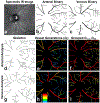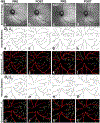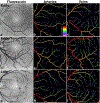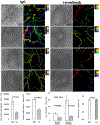Vascular Patterning as Integrative Readout of Complex Molecular and Physiological Signaling by VESsel GENeration Analysis
- PMID: 33839725
- PMCID: PMC9903340
- DOI: 10.1159/000514211
Vascular Patterning as Integrative Readout of Complex Molecular and Physiological Signaling by VESsel GENeration Analysis
Abstract
The molecular signaling cascades that regulate angiogenesis and microvascular remodeling are fundamental to normal development, healthy physiology, and pathologies such as inflammation and cancer. Yet quantifying such complex, fractally branching vascular patterns remains difficult. We review application of NASA's globally available, freely downloadable VESsel GENeration (VESGEN) Analysis software to numerous examples of 2D vascular trees, networks, and tree-network composites. Upon input of a binary vascular image, automated output includes informative vascular maps and quantification of parameters such as tortuosity, fractal dimension, vessel diameter, area, length, number, and branch point. Previous research has demonstrated that cytokines and therapeutics such as vascular endothelial growth factor, basic fibroblast growth factor (fibroblast growth factor-2), transforming growth factor-beta-1, and steroid triamcinolone acetonide specify unique "fingerprint" or "biomarker" vascular patterns that integrate dominant signaling with physiological response. In vivo experimental examples described here include vascular response to keratinocyte growth factor, a novel vessel tortuosity factor; angiogenic inhibition in humanized tumor xenografts by the anti-angiogenesis drug leronlimab; intestinal vascular inflammation with probiotic protection by Saccharomyces boulardii, and a workflow programming of vascular architecture for 3D bioprinting of regenerative tissues from 2D images. Microvascular remodeling in the human retina is described for astronaut risks in microgravity, vessel tortuosity in diabetic retinopathy, and venous occlusive disease.
Keywords: 3D bioprinting; Angiogenesis; Central retinal vein occlusion; Diabetic retinopathy; Keratinocyte growth factor; Leronlimab; Microvascular; Saccharomyces boulardii; Spaceflight-Associated Neuro-ocular Syndrome.
© 2021 S. Karger AG, Basel.
Conflict of interest statement
Conflict of Interest Statement
The authors have no conflicting or competing interests to disclose.
Figures









References
-
- Folkman J (2007) Angiogenesis: an organizing principle for drug discovery? Nat Rev Drug Discov 6 (4):273–286 - PubMed
-
- Wilhelm K, Happel K, Eelen G, Schoors S, Oellerich MF, Lim R, Zimmermann B, Aspalter IM, Franco CA, Boettger T, Braun T, Fruttiger M, Rajewsky K, Keller C, Bruning JC, Gerhardt H, Carmeliet P, Potente M (2016) FOXO1 couples metabolic activity and growth state in the vascular endothelium. Nature 529 (7585):216–220. doi:10.1038/nature16498 - DOI - PMC - PubMed
Publication types
MeSH terms
Substances
Grants and funding
LinkOut - more resources
Full Text Sources
Other Literature Sources

